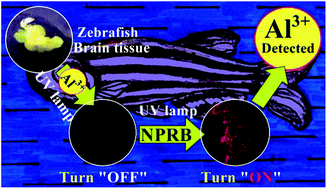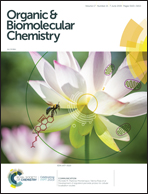Selective sensing of Al3+ ions by nitrophenyl induced coordination: imaging in zebrafish brain tissue†
Abstract
A p-nitrophenyl based rhodamine probe (NPRB) has been designed and synthesized for the selective, real-time detection of Al(III) in aqueous medium with a lower micromolar range detection limit at physiological pH. All the spectroscopic and theoretical analyses validated the proposed 1 : 1 complexation between NPRB and Al3+ along with an 80-fold enhancement in fluorescence intensity. Using the “turn on” response of the probe, binding of NPRB to Al3+ in the brain tissue of adult male zebrafish (D. rerio) has been visualized through fluorescence microscopy.



 Please wait while we load your content...
Please wait while we load your content...